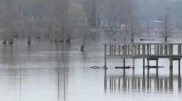Keystone XL Protesting Heats Up At Front Lines
In the battle over the construction of the Keystone XL pipeline, protest actions that span the length of the oil project have sparked national debate.
In the north, over 3,000 protesters gathered on Oct. 22 in front of the British Columbia legislature in Victoria, Canada to oppose the tar sands oil pipeline development. The hashtag of the event, #DefendOurCoast, became a trending topic on Twitter.
In the south, activists are blocking the Keystone XL's construction in Texas by forming blockades, chaining themselves to machinery and residing in trees. At least 29 have been arrested since August, reports the LA Times.
Among those is actress-slash-activist Daryl Hannah, who was helping landowner and "feisty 78-year-old great-grandmother" Eleanor Fairchild trespass on her property to protest development. Fairchild's property was seized by eminent domain, a tactic that was ruled OK by a Texas judge in August.
Others have hesitantly signed agreements to avoid costly legal battles. Susan Scott, another landowner-turned-activist, signed a right of way to TransCanada but took the $22,000 in compensation and buried it in her property.
"I don’t care if it rots. It’s tainted money," she told the New York Times.
Hannah and Fairchild released a PSA this week that encourages the public to sign an open letter to President Barack Obama and Gov. Mitt Romney, outlining the project's threat to the economic and environmental safety of the region.
"Show us, in the tradition of great Americans who came before you, that you are leaders worthy of the American presidency by courageously standing firm in defense of the land, and planet, we love," it states.
WATCH:
Tar Sands Blockade, one of the more dominant groups in opposition to the pipeline, is currently at 30 days residing among the forest trees. Their website features video updates of their non-violent protesting.
Currently, the Keystone XL pipeline's southern stretch -- from Cushing, Okla. to Port Arthur, Tex. -- remains approved by President Obama. Permits were granted by the Army Corps of Engineers.
The northern part, which leads up into the Canadian tar sands, is still under State Dept. review. President Obama has commented that its path needs to be shifted to lessen
environmental impact.
In the midst of these actions, the original Keystone pipeline shut down to review safety issues. The pipeline reopened on Monday.





